English descends from Proto-Germanic, the same ancestor that birthed the modern German language.
Ergo, it should come as no surprise that both the English and German languages have plenty in common.
Aside from the fact that both languages share plenty of words together, their grammar can be quite similar.
More importantly, these two West Germanic languages use almost the same Latin alphabet.
However, seeing as these languages have taken different paths over the past few centuries, there were bound to be a few deviations here and there.
With that in mind, let’s explore the German alphabet with all its wonders.
nbsp;
nbsp;
The German Alphabet from A to Z
Before getting mired in the nuanced details of spelling, pronunciation, and other quirky facts relating to the German language, we should start with the basics.
There are 26 primary letters in the German language, the same 26 you’d find in English. However, there are three extra Umlauts, which bring the total up to 29.
Moreover, some countries consider the Eszett, ß, another letter, which would bring the grand total up to 30 letters.
Let’s start with the basic 26 before we move onto the Umlauts and the Eszett. It’s interesting to note that these letters are also ordered the same way they are in English.
As we learn the 26 letters, we will also learn their German names as well as how they sound when used in a word.
We will start by learning the German name for each letter. For example, the English name for “T” is “tee,” and the English name for “U” is “you.”
Once we’ve learned the name of the letter, we will learn how it sounds when used in the middle of a word, which can be different than the letter’s original name.
Again, if we look at English, the pronunciation of the word “up” is quite different than the pronunciation of the letters making up the word, which are “you” and “pee.”
It should be noted that plenty of the pronunciations that follow are approximate.
Another thing you should be aware of beforehand is that the pronunciations of letters differ from region to region. For example, the letter “S” is pronounced one way in Germany and in a slightly different way in Austria.
Ergo, you might come across different pronunciations online than the ones detailed here, yet the differences will be regional.
A

The “A” in German is pronounced as “ah.” The closest English example that creates the same sound is the “a” in the word “father” or at the beginning of “astronaut.”
But, its pronunciation when placed in a world depends on several factors seeing as it is a vowel. We will discuss this more in-depth later on.
Example:
“Der Adler,” which translates to eagle
“Januar,” which is the month of January
B

An approximate pronunciation of “B” is “bay,” the same one you have in the word “baby.”
When this letter comes at the beginning of a word or in the middle, it sounds the same as it would in English. However, when “B” comes at the end of a word, it sounds more like “p.”
Example:
“Der Bruder,” which is German for brother.
“Aber,” which means but
“Kalb,” which means calf
“Korb,” which translates to basket
C

The Germans pronounce it as “tsay,” but, again, this is a simple approximation.
This consonant can be a bit tricky when put in the middle of a word. For one thing, “C” is part of a couple of combined letters, which have their own unique pronunciation, but that will be explored later.
Assuming that “C” isn’t part of a combination, when it comes at the beginning of a word, it is pronounced as “k.”
Conversely, when “C” comes at the beginning of a foreign word, it can either have the sound of “ts” or “ch.” Also, if the letter following “C” is “E,” “I,” “Y,” “ä,” or “ö,” then it is pronounced as “ts.”
If you feel confused, the following examples should help clarify matters up.
Example:
“Cafe,” which is the same word as in English. And, the “C” here is pronounced as “k.”
“Celsius,” which is a degree for measuring temperature. The “C” at the beginning here is pronounced as “ts.”
“Cello,” which is the musical instrument you might see at the Opera. The “C” here is pronounced as “ch” because this is a foreign word.
D

While English speakers pronounce this letter as “Dee,” Germans pronounce it as “Day.”
When “D” comes at the beginning of a word, it sounds like its English relative. But, if it comes at the end of a word, at the end of a syllable, or before consonants that are voiceless, it is pronounced as “t.”
Example:
“Dienstag,” which means Tuesday. The “D” here sounds pretty much as you would expect.
“Blind,” has the same meaning as its English relative. But, this word is pronounced as “blint,” with the “D” giving a “t” sound.
E

“E” is pronounced as “ay,” sort of like the first “e” in the English word “elegant.”
Seeing as it is a vowel, how it is pronounced can differ depending on whether it is long or short. We will return to this.
Example:
“Essen,” which means to “eat.”
“Zuerst,” which translates to “first.”
F

This consonant holds no secrets. Everything about it is the same as it is in English. Germans pronounce it as “eff.”
And, when “F” shows up in a word, be it in the beginning, middle, or end, it is pretty much pronounced the way you’d expect.
Example:
“Der Freund,” which means “friend.”
“offen,” a verb that means “to open.”
G

Roughly speaking, this letter is pronounced as “Gay.”
However, it can take on several different pronunciations when used in a word. If “G” comes at the beginning or in the middle of a word, you would pronounce it as “g.” Alternatively, if it comes at the end of a word, it makes a “k” sound. And, if it is part of the suffix “-ig,” then it gives you an “-ich” sound.
(If you’re wondering what an “-ich” sound is, don’t worry. We’ll cover this later on.)
Example:
“Geben,” which means “to give.” Here the “G” is pronounced like in the English word “goat.”
“Tag,” which means “day.” The “G” in this case sounds like “k,” making the word sound like “tahk.” Interestingly, this is the same “tag” that you’ll find in the German expression “Guten tag,” which literally translates to “good day.”
H

The letter itself is pronounced as “haa.” When placed at the beginning of a word, “H” is pronounced like the “h” in “home.” Also, it is pronounced with that “house” sound when it is succeeded by “a,” “I,” “o,” “u,” “y,” “ä,” “ö,” and “ü.” Otherwise, the “H” is usually silent.
Example:
“Der Hammer,” where the “H” is pronounced like it is in the English word “hammer.”
“Die Mühle,” which means mill. In this word, the “h” is silent.
I

The German name for this letter is pretty similar to the French one. They both call it “eeh,” which almost sounds the same as the “I” in “Igor.”
Again, this is another vowel, so we won’t delve too much into the pronunciation right now.
Example:
“Der Igel,” which means porcupine.
“Der Imbiss,” which means snack.
“Der sieben,” which is the German word for the number “seven.”
J

Now, this letter is one of the large deviations from the English language. Whereas English names “J” “jay,” the Germans call this letter “yot.”
Moreover, when used in a word, the English pronounce it the same way they pronounce the second “g” in “language.”
However, Germans pronounce it as a “y,” the same “y” that comes at the beginning of the word “yellow.”
Example:
“Ja,” which is German for “yes.” It is pronounced as “yah.”
“Das Jahr,” which means “year.”
K

“K” is called “kah” in German. Aside from that, it is almost exactly the same as it is in English. It is pronounced the same when used in a word, regardless of its position.
Example:
“Das Kamel,” which means “camel.”
“Kuchen,” which is “cake.”
L

“L” is named “ell” in German, which is the same as English. But, when this letter is used in a word, it can sound a bit different than what English speakers are used to.
This is why many English speakers may have a hard time pronouncing this letter when learning German.
There are two types of “L” in English. You have the clear “L,” which is clipped. This is the “L” that comes at the beginning of words like “lamp” and “land.”
Alternatively, you have the drawled out “L”, the one that comes at the end of words like “rattle” and “will.”
The thing is that the German language only has one kind of “L,” the clipped “L.”
This can confuse English speakers because their instincts may draw them towards using the drawled “L,” which doesn’t exist in German.
Example:
“Die Leute,” which means “people.”
“Das Land,” which is “land.”
M

Seeing as this consonant is pronounced and used in the same way as its English counterpart, there is no reason to dwell here.
Example:
“Der Mann,” which means “the man.”
“Die Ameise,” which means “the ant.”
N

Again, this letter is pronounced and used like in English.
Example:
“Nicht,” which means “not.”
“Die Münze,” which means “coin.”
O

This vowel is named “oh” in both German and English.
Since it is a vowel, we will postpone delving into its different pronunciations when used in words.
Example:
“Ostern,” which means “Eastern.”
“Rot,” which translates to “red.”
P

While this letter is called “pee” in English, it is pronounced “pay” in German. Other than that, it is used in the same way and sounds the same when used in a word.
Example:
“Die Polizei,” which means “the police.”
“Der Apfel,” which means “apple.”
Q

What English speakers know as the letter “cue” is known to Germans as the letter “koo.” But, just like English, this letter is always followed by the letter “u,” making it always appear in the combination “qu.”
However, while the English combination is pronounced “kw,” the German combo is pronounced as “kv.” This is partly because the Germans don’t have the “W” sound even though they have the “w” letter.
Example:
“Quatsch,” which means “nonsense.” The word is pronounced as “kvach.”
R

The Germans call it “er,” which isn’t too dissimilar to how it is called in English. Nevertheless, “R” is one of the more difficult German consonants to pronounce as you shall see shortly.
For starters, there are two types of “R.” You have the consonantal “R” and the vocalic “R.”
The consonantal “R” can be difficult to get right. In fact, it can be very off-putting for people learning the language.
When in the middle of a word, “R” takes a guttural sound, one that is foreign to English speakers.
The sound comes from the uvula, which is at the back of the throat, and resembles the sound you make when you are gurgling.
However, given how alien the consonantal “R” can be, some learners have just settled for rolling the “R”’s from the tips of their tongues, the same way you would in Spanish.
Alternatively, the vocalic “R” gets its name due to the fact that its pronunciation is very similar to that of a vowel. It is pronounced similar to the “schwa,” a very common vowel sound in German, giving the vocalic “R” the nickname of the “dark schwa.”
The vocalic “R” appears in unique circumstances only. For instance, it can show up in the unstressed “-er” syllables that are used at the end of several German words.
Example:
“Meer,” which means “sea.” The “R” at the end is vocalic.
“Meere,” which means “seas.” The “R” here is consonantal, As you can see, the only difference between both examples is the vowel “e” at the end. However, this “e” can change the pronunciation drastically.
“clever,” which means “clever.” (Are you really surprised at this point at the similarities between English and German?) The “R” in this example is vocalic.
“Der Clevere,” which means “the clever one.” The “R” here is consonantal.
S
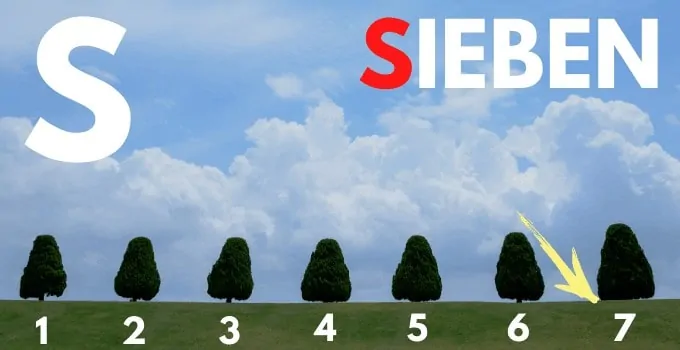
“S” is called “es” in German. However, despite the apparent similarity to English, “S” is pronounced differently depending on where it is in a word.
When it comes at the beginning of a word, “S” is pronounced as “Z,” the same “Z” that can be found in the English word “zoo.”
Alternatively, when it comes in the middle of a word, “S” is pronounced normally, just like it is in English.
Example:
“Sieben,” which means “seven.” However, since the “S” is at the beginning, it is pronounced as “Z.” So, the word sounds like “Zee-ben.”
“Haus,” which means “house.” The “S” here is pronounced normally, making the word pronounced identically to its English counterpart. It sounds like “house.”
T
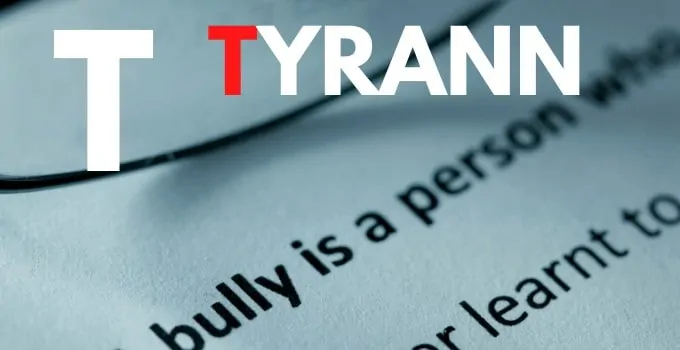
The approximate name of this letter in German is “tay.” It gives off a sound that is more dental than its English counterpart. Other than that, “T” in German and “T” in English are almost the same.
Example:
“Der Tyrann,” which means “tyrant.”
“acht,” which is German for “eight.”
U

Called “ooh,” “U” is another German vowel, meaning that it is subject to the same rules of pronunciation that constrain all other German vowels.
Example:
“Die Universität,” which means “university.”
“Der Mund,” which means “mouth.”
V
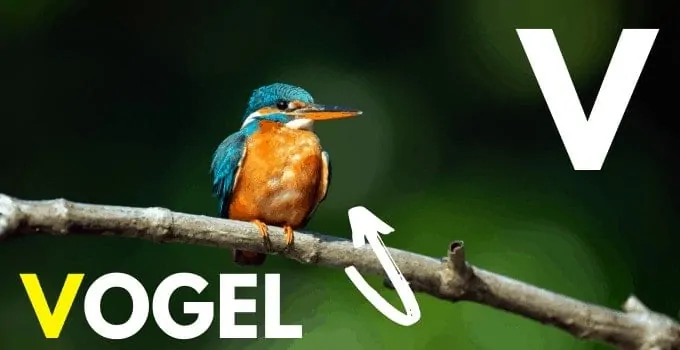
This letter and the following one both took me by surprise when I first learned about them.
The Germans call this letter “fow.”
It can either give an “F” sound or a “V” sound depending on the circumstances.
“V” is pronounced as “F” when it comes at the end of a word or when it is used in certain prefixes such as “ver-” and “vor-.” There are other words that make the “V” sound like “F,” most of which are words that are native to the German language. Over and above, whenever “V” is used at the start of a German geographical name or a family name, the letter is pronounced as “F.”
Alternatively, “V” is pronounced as “V” in the majority of other cases that haven’t been mentioned above. Moreover, most foreign words adopted by the German language give off the “V” sound.
Example:
“Vogel,” which means “bird.” It is pronounced as “foh-gel.”
“Vase,” which translates to “vase.” It is pronounced as “vah-ze,” where the “V” becomes more familiar to the English speaking world.
W

The German name “W” “vay.” While “V” is usually pronounced as “f,” “W” is actually pronounced as “v.”
Believe it or not, the Germans don’t have the “W” sound in their language. This is why plenty of Germans may have a hard time learning English, especially when it comes to pronouncing a word as simple as “we.”
Example:
“Die Wange,” which means “cheek.” It is pronounced as “Van-ge.”
“Das Schwein,” which translates to “pig or swine.” Again, Germans pronounce this word as “Schvine.”
X
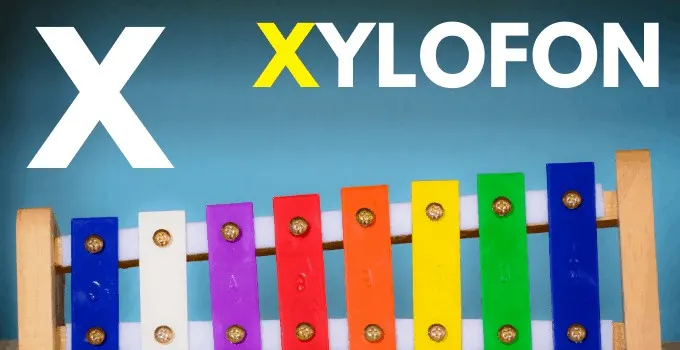
“X” is called “ix” in German, and it functions pretty much in the same way it does in English. And, similar to English, words starting in “X” are rare in German.
Example:
“Das Xylofon,” which translates to “Xylophon.”
Y

So far, most of the letters we have seen have similar names to their English counterparts. Yet, this letter is a bit different. The Germans call “y” “ypsilon,” which is pronounced “uep-si-lohn.”
When used in a word, “Y” can be pronounced in one of two ways. On the one hand, when used in foreign words, “Y” makes the familiar “y” sound found in English words like “yellow.” On the other hand, when used in native German words, “Y” mostly makes the sound made by “ü,” a sound we will explore soon.
Example:
“Der Yeti,” which means “Yeti.” It is also pronounced the same way the English version is pronounced.
“System,” which translates to “system.” However, the “Y” is pronounced differently, making the word sound like “zers-teym.”
Z
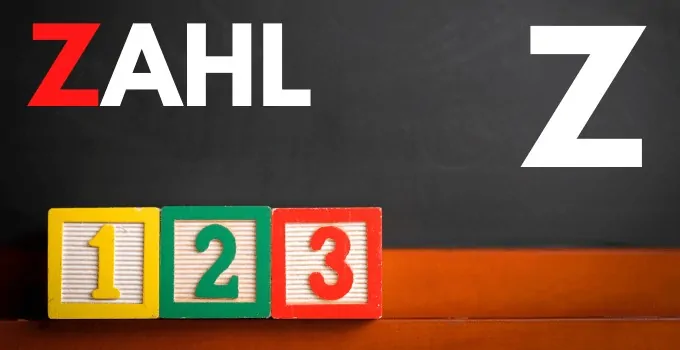
Germans call this letter “tset,” which isn’t all that different from the English counterpart. However, while the English “Z” creates more of a buzzing sound when used in a word, the German “Z” sounds like you strung the letters “t” and “s” together.
Example:
“Zahl,” which translates to “number.” It is pronounced as “tsahl.”
The German Alphabet: A few more considerations
We have now finished the 26 main letters of the German alphabet. These are the letters that all German-speaking regions agree on. The remaining four letters, the three Umlauts and the Eszett, differ by region.
Before moving on to the aforementioned four unique characters, let’s look at a few special considerations regarding the main alphabet.
The pronunciation of vowels
There are five main German vowels. You have “A,” “E,” “I,” “O,” and “U.” The three Umlauts are also considered as vowels.
Now, vowels can be pronounced either short or long. You pronounce a short vowel when the vowel is succeeded by a cluster of consonants. In most other cases, the vowel takes a long pronunciation, especially when it is followed by a single consonant.
Short and long refers to how long you hold or draw out the vowel sound. For instance, in English, the “A” in “farmer” and “father” is a long vowel. Alternatively, the “O” in “mop” is a short vowel.
Obviously, there will always be exceptions to the above-stated rule, but it works well as a simple rule-of-thumb. Also, whether you go with a long or short vowel depends on whether the syllable is stressed or not, but there is no need to dive too deep into that rabbit hole right now.
However, some vowels that are supposed to be short get a long sound on purpose. This can be done by doubling the vowels or by adding an “H” after the vowel. For instance, the “A” in the German word “Staat,” which means “state,” is pronounced long because of the doubling. Also, the same goes for the “A” in “Stahl,” which means “steel,” but this time is because of the “H.”
With this in mind, we can now look at the five main vowels and learn both their long and short pronunciations.
A
The short “A” sounds a bit like “u” in “hut.”
The long “A” sounds a bit like the “A” in “father.”
E
The short “E” resembles the “E” in “get.”
The long “E” sounds like the “A” in “laid.”
Interestingly, when a word ends in “E” or “-er,” it gives off the sound you hear at the end of the word “idea.”
I
The short “I” sounds like the “I” in “mitten.”
The long “I” sounds like the double “e” in “seed.”
O
The short “O” gives off the same sound of the “o” in “knot.”
The long “O” is the same as the “O” in “so.”
U
The short “U” sounds the same as the double “O” in “foot.”
The long “U” produces the same sound as the double “O” in “pool.”
German Alphabet: German Diphthongs
Just as in English, German vowels combine together to produce new sounds. Here are a few examples you might be interested to know.
“AI,” “AY,” “EI,” and “EY” all produce the same sound of the English word “eye.”
“AU” gives off the “ou” sound you hear in “house.”
“IE” produces “ee”
“EU” and “ÄU” create the “OY” sound you come across in words like “annoy.”
Combination of German consonants
In German, there are a few cases where consonants combine together to create new sounds that can’t be found in English.
Here are a few examples you need to be aware of.
One of the most infamous combinations is “CH,” a combination that has tripped many a beginner.
The sound this combination produces can’t even be likened or approximated to anything in English. It requires learning a new sound, one that is sort of like gargling but isn’t. You have to hear it for yourself.
However, when “CH” is combined with “S,” giving us “CHS,” this combination is often pronounced as “X.”
On the other hand, when the “S” comes first, producing “SCH,” the resultant sound is closer to “SH.”
The three Umlauts and the Eszett
Umlauts are normal vowels, namely “A,” “O,” and “U,” with umlauts above them.
Some consider them as letters, whereas others just think that they are special cases of the original vowels, which is why they believe that the Umlauts shouldn’t be considered as their own thing.
On the other hand, the Eszett may seem like a unique character, but it really is “SS” in disguise. In fact, some countries like Liechtenstein and Switzerland don’t even have this letter.
Let’s look at each of these letters separately.
Ä
When used in a word, the A Umlaut produces an “E” sound that resembles the sound you hear in the word “melon.”
Example
“ähnlich,” which means “similar.”
“gähnen,” which means to “yawn.”
Ö
When used in a word, “Ö” gives off a sound that is close to the “I” in “girl.”
Example
“Österreich,” which is German for “Austria.”
“Der Löwe,” which translates to “lion.”
Ü
There really is no sound in the English language that is similar to the sound produced by the U Umlaut, making it quite difficult to send across the sound through the written word. The English language doesn’t even have an approximate.
Example
“Über,” which means “over.”
“Müde,” which translates to “tired.”
ß
The Esszet gives off a double “S” sound, sort of like a stressed “S.” The countries that don’t use the Esszet replace it with two “S”’s.
Example
“Heiß,” which translates to “hot.”
“Die Straße,” which means “street.”

Hey fellow Linguaholics! It’s me, Marcel. I am the proud owner of linguaholic.com. Languages have always been my passion and I have studied Linguistics, Computational Linguistics and Sinology at the University of Zurich. It is my utmost pleasure to share with all of you guys what I know about languages and linguistics in general.

